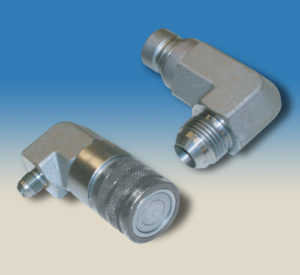
Quick-connect couplings are connectors or fittings used to mate fluid lines with equipment that requires repeated connections and disconnections. They are used in both hydraulic and pneumatic applications, and are designed for easy hand operation for use with fitting attachments primarily on mobile machinery.
Their design is simple: a male end—or plug—is inserted into a female end—or socket—to make a secure, leak-tight seal. They are sometimes called push-to-connect because connecting them requires only a quick push.
They usually feature a one-way sleeve to allow for break-away with a tool when a coupling is clamp mounted. Two-way sleeves allow for one-hand disconnection. In two-way designs, twisting and pulling the two ends breaks the connection.
These locking seal quick-connect couplings are created by several designs, including:
Ball or bearing type, in which spring-loaded balls lodge in cavities to make the connection. This is the most common type, because they can be disconnected with just one hand.

Flat face designs eliminate the problems of trapped pressure in a line, as well as leakage of hydraulic fluid or air by eliminating the cavity where the fluid or air rests. They can be push-to-connect or threaded, screw-in types. Flat face couplings provide high flow and low pressure drop and their sleeve-locking feature reduces the change of accidental connection.
Non-latching designs are best used when there may be frequent change-outs of the coupling, such as pneumatic ones used in test or medical applications. They usually come with a self-sealing valve that will hold the fluid in the line to prevent any leakage.
Bayonet couplings are simple to connect. The user plugs the two ends together and once engaged, gives the devices a quarter-turn to push the male end into the female socket. Twisting them a quarter turn the other direction allows them to be easily disengaged and separated. Although used in high-pressure hydraulics, they are more common in pneumatic applications.

Leave a Reply